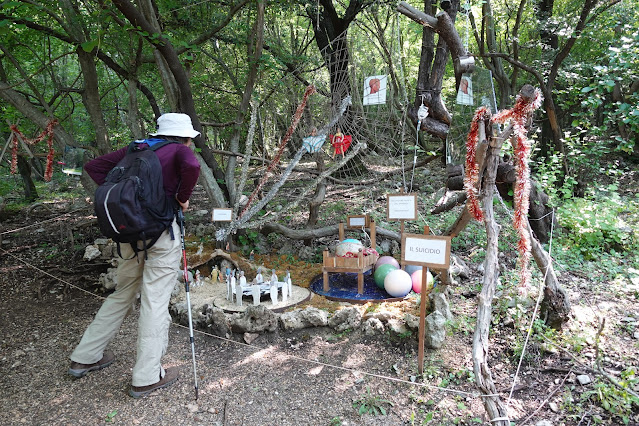 |
| The view (away from Rome) from Monte Gennaro's decorated peak (that's the base of the mountain-top cross at left). |
Maybe not so much the season, as dreams of the season - one of our favorite hikes - and this is a real one, not a cushy one. Up "Rome's mountain" (though bearing the name of Naples's patron saint), the tallest mountain one can see from the city, Monte Gennaro, in the Lucretili range to the northeast of Rome. Yes, you can see it from the Gianicolo, and many other high spots in Rome.
There are marked trails up to the peak from many different directions, and we've tried them all. One of our favorites is one filled with "tornanti" or switchbacks (a switchback is also called "lo zigzag"), 25 in fact - they are even numbered.
 |
| The defunct funicular (and its path up the first shoulder of the mountain. |
 |
 |
| Below the sign that includes "shame on you," is a turquoise globe, wrapped like a baby (or patient), hooked up to a heart monitor. |
We're not sure what the large underwear on Ken and Barbie mean, but the larger diorama is a critique of inaction over climate change. The lettered signs in the diorama read:
"It was the most beautiful planet of the universe; shame on you" and "Suicide" and, on the far left, with figurines of a creche, "Hope."
From a saddle (yes, the Italians use the word too, "sella"), one can see the path to a tower (right) - we've never bothered to go there, because it's private and the 'path' is a road. The trail marker has estimated hours to the destination, not the distance.
There are some "ruins" where the funicular ended and a hotel was located. There are also way too many cell towers:
One can take a small loop starting at this point (and get lost, but not very lost, except if it's foggy at the top - believe me, we've done it all).
Here's AllTrails view of the mostly up-and-back trail, with its great switchbacks:
We often run into a few people at the top. This day it was 2 trail runners (!!). They asked to have their photo taken with us, shocked at finding Americans on the peak, and then ran their merry way down the rocky summit.
 |
| The smaller peak with the tower is visible in the distance. The two trail runners had an intense discussion below us about their favorite power bars. |
And the gorgeous woods the switchbacks wind through, as we finish the journey:
Dianne




























